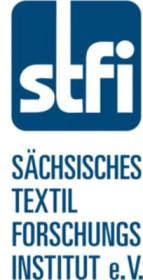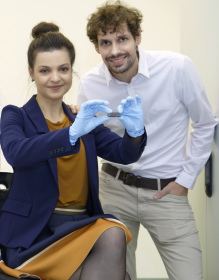STFI auf dem Innovationstag Mittelstand des BMWK
Beim Innovationstag Mittelstand des Bundesministeriums für Wirtschaft und Klimaschutz (BMWK) präsentiert sich der innovative Mittelstand als treibende Kraft der deutschen Wirtschaft. Unter dem Leitgedanken „So geht Zukunft! – Digital. Transformativ. Resilient.“ verspricht die Veranstaltung spannende Einblicke in wegweisende Technologien und zeigt, wie Unternehmerinnen und Unternehmer aus ganz Deutschland den technologischen Wandel vorantreiben. Rund 300 Aussteller präsentieren bei der Open-Air-Veranstaltung die Ergebnisse ihrer zukunftsweisenden Forschungs- und Entwicklungsprojekte und laden zur Entdeckungsreise ein. Das STFI präsentiert zum Innovationstag Mittelstand des BMWK am 13.06.2024 in Berlin fünf textile Forschungshighlights aus den Bereichen Schutztextilien, Digitalisierung sowie Nachhaltigkeit, Kreislaufwirtschaft und Wellness.
Molotowcocktailschutzanzug – textiler Schutzanzug für Polizeieinsatzkräfte zum Schutz vor Molotowcocktails
Spezialeinsatzkräfte sind auf Schutzkleidung angewiesen, die vor vielfältigen Gefahren schützt. Meist schränkt eine höhere Schutzwirkung den Tragekomfort ein. Forscher des STFI und des ITA Aachen haben daher gemeinsam ein hitzebeständiges Gewebe entwickelt, das vor Angriffen mit Molotowcocktails schützt und dabei gleichzeitig einen hohen Tragekomfort gewährt. Molotowcocktails können schwerwiegende Verletzungen hervorrufen, die es zu verhindern gilt. Das Verletzungspotential hängt insbesondere mit der extrem hohen Verbrennungstemperatur von 800 °C – 1.700 °C zusammen, aber auch der starken adhäsiven Wirkung der Brandsätze. Die entwickelte Schutzkleidung zeichnet sich durch eine optimierte Faserzusammensetzung sowie durch eine spezielle Garn- und Gewebekonstruktion aus. Dar-über hinaus wurde die Funktionalisierung des Gewebes angepasst.
Holz/Textil-Faltwerke
Im abgeschlossenen Projekt wurden Holz-Textil-Faltwerken (HTF) entwickelt, die temporär zum Zweck des Schallschutzes, Sichtschutzes oder der räumlichen Abgrenzung aufstellbar sind. Unter Nutzung der Origami-Mathematik wurden mehrschichtige Holz-Textil-Verbunde entwickelt. Das Textil dient als zweidimensionales Scharnier der fertigen Konstruktion. Durch den Verbund aus biegeschlaffen textilen Materialien mit biegesteifen Holzelementen sind Faltbewegungen möglich, die eine selbsttragende Struktur entstehen lassen. Die HTF zeichnen sich durch kleines Packvolumen und Leichtbauweise aus. Gezeigt wird ein Tischmodell des Demonstrators.
Graviola
In der Naturmedizin werden die Blätter des tropischen Graviola-Baumes (Annona muricata) zur Verbesserung des Wohlbefindens und zur Behandlung zahlreicher Krankheiten eingesetzt. Die Wirkung der Graviolapflanze ist hauptsächlich auf die enthaltenen aktiven Wirkstoffe der Acetogenine zurückzuführen. Ziel des Projektes GRAVIOLA war die Entwicklung neuartig funktionalisierter Textilien, die mit Wirkstoffen der Graviolapflanze ausgerüstet sind. Gezeigt werden auf dem internationalen Pavillon des Innovationstag Mittelstand mit Graviola ausgerüstete Textilmuster auf Basis von Wirkstoffverkapselungen und Graviolaextrakten.
INTAKE – Entwicklung und Erprobung intelligenter Einbringungstechnologie für Datenkerne in der Wäschekonfektionierung
Im Projekt INTAKE haben sich aktuell sechs Forschungspartner das Ziel gesetzt, ein KI-gesteuertes Verfahren zu entwickeln, das RFID-Antennenfäden und -Chips während des Konfektionsprozesses in die Wäsche einbringt und so die Notwendigkeit des nachträglichen Patchens eliminiert. Die Wäsche selbst wird so zu einem individuell funktionalisierten RFID-Transponder gemacht. Gezeigt wird Flachwäsche wie z.B. Bettlaken oder Kopfkissen mit integrierter kleindimensionaler RFID-Fadentechnologie inkl. Datenkern und Textilantenne für eine gesteuerte Einbringung per KI und zukünftige Leasing-Szenarien
Entwicklung und Untersuchung der Fusion zwischen innovativen Technologiekombinationen und nachhaltigen Designstrategien, dargestellt als multifunktionale Spielmatte (MultiMatt)
Die Multimatt ist eine Spielmatte, welche unterschiedliche Fertigungs- und Veredlungstechnologien unter Verwendung eines rezyklierten und Cradle to Cradle-zertifizierten Materials zu einem kreislauffähigen Produkt vereint. Die entwickelte MultiMatt verbindet den Monomaterial-Ansatz mit dem Flächenbildungsverfahren Stricken und den Veredlungs- und Funktionalisierungstechnologien 3D-Druck, Rückenbeschichtung und Laserbehandlung. Damit ist die Entwicklung zur Anwendung für nachhaltiges Design, kreislauffähige Materialverbunde und Rezyklate geeignet.
Sächsisches Textilforschungsinstitut e.V. (STFI)







